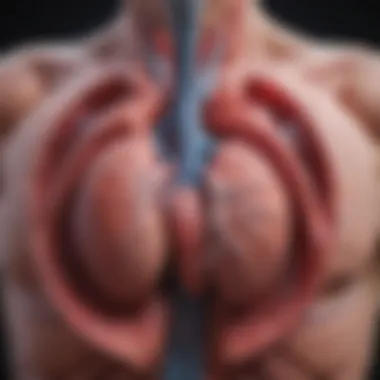Complications of Pulmonary Hypertension Explained


Intro
Pulmonary hypertension (PH) emerges as a serious medical challenge, often understated in its complexities. The condition involves elevated blood pressure in the pulmonary arteries, leading to significant physiological and clinical repercussions. Patients with pulmonary hypertension may experience a range of complications that can dramatically alter their health trajectory and overall quality of life. As the disease progresses, the impact on the heart, lungs, and even the entire body becomes more pronounced, necessitating a comprehensive understanding of these complications.
The complexity of pulmonary hypertension not only resides in its direct effects but also in its pathological consequences. From heart failure to blood clots, the array of complications is vast and varied, demanding a meticulous approach in management. This article aims to dissect these complications, exploring their underlying mechanisms and clinical manifestations. Furthermore, it seeks to emphasize how a deeper understanding can aid healthcare professionals in delivering optimal care.
Article Overview
Summary of Key Findings
Pulmonary hypertension leads to several severe complications:
- Right Heart Failure: As the right side of the heart struggles against increased pressure, it may weaken and ultimately fail, leading to shortness of breath and fatigue.
- Thromboembolic Events: Patients are at heightened risk for blood clots in the lung arteries, which can lead to pulmonary embolism.
- Arrhythmias: Irregular heartbeats can arise as the heart adapts to the altered hemodynamics.
- Cor Pulmonale: Chronic lung disease exacerbates the strain on the heart, further complicating the patient’s condition.
These findings underscore the need for vigilance when managing patients with pulmonary hypertension, as early identification and intervention can significantly influence outcomes.
Research Objectives
The primary goals of this article are:
- To explore the various complications associated with pulmonary hypertension.
- To examine the pathophysiology behind these complications.
- To discuss clinical manifestations that healthcare providers should recognize.
- To analyze the implications for treatment and management strategies.
By addressing these objectives, healthcare professionals will be better equipped to manage the multifaceted challenges presented by pulmonary hypertension.
Overview of Pulmonary Hypertension
Pulmonary hypertension is a serious condition that demands our attention due to its intricate nature and potential complications. Understanding it is crucial for both medical professionals and patients affected by this disease. As pulmonary hypertension progresses, it leads to significant physiological changes that can drastically alter a patient's quality of life and overall health status.
Definition and Classification
Pulmonary hypertension is defined as a sustained increase in mean pulmonary arterial pressure, typically exceeding 25 mmHg at rest. The classification of this condition is critical, as it encompasses various subcategories that differ in etiology, clinical presentation, and management. The World Health Organization has categorized pulmonary hypertension into five groups, distinguishing between different underlying causes, such as left heart disease, pulmonary lung diseases, chronic thromboembolic causes, and more. Each classification category informs treatment approaches, making it essential for healthcare providers to accurately diagnose and classify the type of pulmonary hypertension affecting a patient.
Etiology of Pulmonary Hypertension
The etiology of pulmonary hypertension is diverse, incorporating genetic, environmental, and comorbid factors. Many patients may experience idiopathic pulmonary arterial hypertension without a clear identifiable cause, while others may develop the condition due to chronic obstructive pulmonary disease, interstitial lung disease, or congenital heart defects. Understanding these underlying factors is vital, as it allows for tailored management strategies and aids in predicting disease progression.
Pathophysiology
At the core of pulmonary hypertension lies complex pathophysiological mechanisms that include vasoconstriction, vascular remodeling, and thrombosis. The increase in pulmonary arterial pressure leads to progressive right ventricular hypertrophy and may ultimately result in right heart failure. By comprehending these processes, clinicians can better anticipate the complications that may arise and implement interventions aimed at slowing disease progression.
A deep understanding of pulmonary hypertension not only illuminates the mechanics of the disease but also highlights the necessity of a cohesive treatment plan. Identifying the various facets of this condition mitigates the risks of missed diagnosis and empowers healthcare professionals to provide comprehensive care.
"A profound knowledge of pulmonary hypertension enhances the ability to address its multiple complications effectively."
The insights gained through examining this condition remain instrumental in managing affected patients, ensuring they receive optimal care tailored to their specific needs. This comprehensive overview lays the groundwork for further exploration of the intricate complications associated with pulmonary hypertension.
Complications of Pulmonary Hypertension
The complications arising from pulmonary hypertension (PH) are crucial to understand for anyone impacted by this condition. Each complication can significantly alter patient outcomes and quality of life. Failing to recognize these complications can lead to inadequate treatment and poor prognoses. This section delves into these complications, allowing for a comprehensive grasp of their implications.
Cor Pulmonale
Definition


Cor pulmonale refers to the alteration of the right ventricle of the heart due to diseases affecting the lungs. This condition is characterized by hypertrophy or dilation of the right ventricle. It often results from chronic obstructive pulmonary disease or pulmonary hypertension. This definition is central to understanding the heart's adaptation to increased vascular resistance in pulmonary arteries.
The key characteristic here is the heart's response to increased pressure, which eventually leads to heart failure if not addressed. Recognizing cor pulmonale is beneficial for treatment strategies.
Pathophysiology
The pathophysiology of cor pulmonale involves the interplay between increased lung pressure and right ventricular function. Initially, the right ventricle adapts, thickening its walls to manage the added stress. However, chronically elevated pressures lead to right ventricular dysfunction. This topic is essential for comprehending how untreated pulmonary hypertension progresses, making early identification critical.
A significant feature of this pathophysiology is the direct correlation between the severity of pulmonary hypertension and the degree of right ventricular strain, which underscores the urgent need for effective monitoring and intervention.
Clinical Implications
Understanding the clinical implications of cor pulmonale is vital for healthcare professionals. It influences treatment decisions, including the need for oxygen therapy or medications like diuretics. The impact is evident; timely recognition can reduce hospitalizations and improve quality of life. An important note is that cor pulmonale can be reversible, especially when treated early, which emphasizes the importance of proactive management approaches.
Right Ventricular Dysfunction
Mechanisms of Dysfunction
Right ventricular dysfunction in the context of pulmonary hypertension arises from prolonged pressure overload. There are several mechanisms involved, including altered myocardial metabolism and fibrosis. These mechanisms highlight how the right ventricle fails under sustained stress. This is a crucial point: understanding these mechanisms helps tailor treatment options to improve heart function.
Specifically, myocardial stretches and strains lead to inefficiencies, indicating that the early stages of dysfunction may be subtle yet significant to patient care.
Assessment Techniques
Assessing right ventricular dysfunction can involve various techniques, including echocardiography and cardiac MRI. Non-invasive measurements like these are essential to reflect the right ventricle's size and function accurately. The benefit of these techniques is that they allow for better prognosis assessments and tailored therapy.
Advanced imaging techniques provide unique insights, showing potential changes before clinical symptoms appear, which is advantageous for early intervention.
Management Strategies
Management involves lifestyle changes, medications, and possibly surgical interventions. Options include pulmonary vasodilators like sildenafil and lifestyle modifications. Understanding the management strategies is crucial for optimizing patient outcomes and slowing progression.
Treatment approaches must be individualized based on the severity of dysfunction. Moreover, a comprehensive management plan can significantly enhance functional capacity and improve overall life expectancy.
Thromboembolic Events
Types of Thromboembolism
Thromboembolic events can pose serious risks in patients with pulmonary hypertension. The most common types include pulmonary embolism and venous thromboembolism. These conditions arise mainly due to blood clots forming in the deep veins and traveling to the lungs. Understanding these types is crucial for recognizing warning signs and ensuring timely treatment.
This knowledge is vital since these complications can suddenly impede blood flow, leading to increased morbidity or mortality if not treated promptly.
Risk Assessment
Risk assessments for thromboembolic events often include patient history and specific screening tools. Factors like immobility or recent surgeries may increase the risk. Identifying at-risk patients allows for preventive measures and personalized care plans.
Notably, a proactive approach can mitigate the likelihood of unexpected complications, significantly improving patient safety.
Preventive Measures
Prevention strategies may include anticoagulation therapy and lifestyle recommendations. Effective preventive measures can diminish the chances of thromboembolic events occurring in patients with pulmonary hypertension. Understanding these measures is essential, as they can greatly enhance patient outcomes.
Moreover, the importance of education regarding potential risk factors amongst patients plays a pivotal role in prevention.
Arrhythmias
Types of Arrhythmias
Patients with pulmonary hypertension are at risk for various arrhythmias, including atrial fibrillation and ventricular tachycardia. These arrhythmias can complicate the clinical picture significantly. Understanding arrhythmia types helps healthcare providers anticipate complications and prepare treatment options.
Each type presents unique challenges and requires distinct approaches for intervention, emphasizing comprehensive cardiovascular assessments.


Causes and Risk Factors
The causes of arrhythmias in pulmonary hypertension are multifactorial, often related to structural changes in the heart muscle. Risk factors can include electrolyte imbalances and hypoxia. Identifying these factors is crucial in crafting effective management strategies as they directly relate to arrhythmia development.
The interplay of arrhythmias and pulmonary hypertension underscores the need for ongoing monitoring and timely interventions, facilitating better management.
Management Approaches
Management of arrhythmias can involve antiarrhythmic drugs and device therapy, depending on the severity and type. This understanding is beneficial as effective treatment reduces risks associated with arrhythmias, leading to better clinical outcomes.
Implementing a tailored approach based on individual patient characteristics is essential in managing arrhythmic complications effectively.
Heart Failure
Understanding Heart Failure in PH
Heart failure due to pulmonary hypertension often involves a complex interplay of right heart strain and systemic factors. Understanding how PH leads to heart failure is vital for healthcare providers in making accurate assessments and interventions. Recognizing this aspect highlights the chronic pressure overload's impact on the heart's function, which informs monitoring and management strategies.
Signs and Symptoms
Common signs and symptoms of heart failure include shortness of breath, fatigue, and edema. Recognizing these signs is essential for early intervention. Understanding the characteristic symptoms informs the approach towards evaluation and management.
Prompt identification of these symptoms encourages timely care adjustments, ultimately improving patient outcomes.
Treatment Options
Treatment options can range from pharmacological therapies to surgical interventions such as heart transplants. The choice of treatment depends on the severity of heart failure and the underlying causes. Understanding various treatment options is fundamental to crafting effective care plans.
Adapting treatment strategies based on evolving patient conditions enhances the efficacy of the interventions.
Exercise Intolerance
Pathophysiology of Intolerance
Exercise intolerance in pulmonary hypertension stems from a variety of physiological factors, including impaired oxygen delivery and increased systemic vascular resistance. Understanding these factors is important for tailoring rehabilitation programs.
The complexity of exercise intolerance significantly impacts patients, necessitating targeted and individualized strategies to address their specific needs.
Impact on Quality of Life
Reduced exercise capacity often leads to diminished quality of life for patients. It can limit daily activities and worsen overall health. Understanding this impact informs the approach to patient management and underscores the need for comprehensive treatment plans aimed at improving functional capacity.
Fostering a better quality of life becomes a prime goal in managing patients with pulmonary hypertension, guiding effective interventions.
Rehabilitation Strategies
Rehabilitation strategies may include supervised exercise programs and pulmonary rehabilitation focused on improving physical function. These strategies are vital as they directly contribute to enhancing quality of life. Understanding these options enables healthcare professionals to implement effective rehabilitation tailored to patients' capacities and limitations.
Adopting personalized rehabilitation strategies enhances outcomes and fosters a proactive engagement in self-care among patients.
Psychosocial Implications
Emotional Challenges


Patients with pulmonary hypertension often face emotional challenges such as anxiety and depression. Understanding these challenges is crucial, as they can significantly affect adherence to treatment and overall well-being. Recognizing the psychological impact can lead to targeted interventions aimed at improving emotional health.
Addressing emotional challenges plays a significant role in enhancing treatment effectiveness and overall patient satisfaction.
Support Systems
Strong support systems can alleviate some emotional burdens faced by patients. Family, friends, and support groups play a pivotal role in this regard. Recognizing the importance of these systems allows healthcare providers to integrate support into care plans effectively.
The strength of social support is a crucial factor in maintaining patient motivation and engagement in their health journey.
Coping Strategies
Coping strategies, such as stress management techniques and counseling, are vital for helping patients deal with the emotional toll of pulmonary hypertension. Understanding these strategies can significantly impact patients' resilience and ability to engage in their care.
Integrating effective coping mechanisms into treatment plans can markedly enhance the patient's ability to handle the psychosocial challenges associated with pulmonary hypertension.
Impact on Comorbid Conditions
Interactions with Other Diseases
Pulmonary hypertension often coexists with several other conditions, such as heart disease and diabetes. Understanding how these interactions occur is critical for managing complications. Recognizing the significance of comorbidities helps in developing comprehensive care strategies tailored to the complex needs of the patient.
Management of Comorbidities
Management of comorbidities involves careful monitoring and potential adjustments in treatment strategies to accommodate multiple conditions. This understanding is essential for optimizing overall health outcomes in affected patients.
Holistic approaches to care that address all health conditions simultaneously improve patient satisfaction and outcomes.
Holistic Care Approaches
Holistic care approaches take into account the patient's physical, emotional, and social well-being. Recognizing the importance of these approaches allows caregivers to address the multifaceted nature of pulmonary hypertension effectively. Integrating holistic care strategies promotes comprehensive health management that leads to improved quality of life outcomes.
In summary, the complications of pulmonary hypertension are varied and intricate. Each aspect necessitates thorough understanding and proactive management. By addressing these complications, healthcare providers can better assist patients in navigating the complexities of this serious condition.
Finale and Future Directions
The topic of complications arising from pulmonary hypertension is crucial in delineating the scope of the condition itself. Understanding these complications not only helps in grasping how pulmonary hypertension affects individuals but also aids healthcare professionals in developing more effective management strategies. As complexity increases, so does the need for a comprehensive approach that can address various aspects of patient care.
The implications of recognizing the severity and nature of complications are multifaceted. Patients who are aware of their condition’s impacts can advocate for themselves and seek timely interventions. Furthermore, educating healthcare providers about the unique patterns associated with these complications is essential. This understanding brings about better diagnostic accuracy and tailored treatment approaches that respect the individual patient’s realities.
Summary of Key Complications
The complications of pulmonary hypertension are extensive and warrant thorough examination. They include:
- Cor Pulmonale: A severe case where the heart's right side is affected due to increased pressure in the pulmonary arteries.
- Right Ventricular Dysfunction: A gradual deterioration of heart function, often presenting challenges for patients.
- Thromboembolic Events: These can arise from clots obstructing blood flow, leading to further complications.
- Arrhythmias: Various heart rhythm disorders increase the risks in individuals with pulmonary hypertension.
- Heart Failure: This can emerge due to sustained pressure overload, significantly affecting daily activities.
- Exercise Intolerance: Physical capacity diminishes, impacting the quality of life.
- Psychosocial Implications: Emotional well-being suffers, necessitating adequate support systems.
- Impact on Comorbid Conditions: Other illnesses can interplay with pulmonary hypertension, complicating treatment regimens.
Research and Innovations
Ongoing research into pulmonary hypertension is vital. Advances in medical technologies and innovative approaches have the potential to improve detection and management. Studies are exploring novel therapies designed to address specific complications while enhancing overall patient outcomes. Some areas of research include:
- New Medications: Investigating drugs that specifically target pulmonary artery pressure.
- Advanced Imaging Techniques: These can offer clearer insights into heart function and the pulmonary vasculature.
- Patient Registries: Collecting data for a robust understanding of disease progression over time and its complications.
By focusing on innovation, it is possible to pave the way for tailored therapies that can more effectively manage the impacts of pulmonary hypertension.
Clinical Implications for Practice
The clinical implications of understanding the complications of pulmonary hypertension cannot be overstated. For healthcare practitioners, knowledge regarding these complications can greatly influence treatment plans. Various aspects include:
- Tailored Treatment Plans: Individualizing management strategies based on complications can lead to better patient adherence and outcomes.
- Multidisciplinary Teams: Collaborating among specialists such as cardiologists, pulmonologists, and therapists is crucial for comprehensive care.
- Regular Monitoring: Ongoing assessments can help in identifying changes in a patient’s condition and adjusting treatments accordingly.







